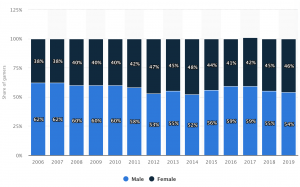Gender in Video Games
Gender in video games refers to how gender identities are portrayed and represented in characters created for the video gaming medium. While gender is often tied to one's physical sex, the expression of gender itself is not inherently tied to any physical characteristics, and can correspond to or differ from physical sexual characteristics assigned at birth.[1] Gender ties more into one's self identity, as well as being a complex social construct that ties into the roles, behaviors, attributes and activities that a society finds appropriate for the male and female sexes. [2] Despite the duality of sexual characteristics in humans, gender can be expressed in a number of ways, which includes identities that do not strictly correspond to male and female. Sexual Identity, which is sometimes misconstrued as gender identity alone, is actually a complex definition of it's own, and while gender identity plays into one's sexual identity, they are not one in the same.[3] A greater portion of games throughout history have focused on characters who identify along this binary scale, and while this is a more widely accepted understanding of gender in society, even these portrayals have created controversy throughout the medium's history.
Contents
History
The history of electronic gaming itself spans nearly 50 years when home consoles such as the Magnavox Odyssey were released back in the early 70's, yet the true heyday of gaming didn't start until the release of the Famicom in Japan, and the Nintendo Entertainment System (NES) to the US and the rest of the world in 1983. The trends that would define how gaming was seen for the foreseeable future, however, had already begun to emerge before the release of this system.
In its early days, large cabinets were needed to produce the improved graphics desired by players over those of the home consoles, and arcades were the dominant place to socialize and enjoy these benefits. Since many gamers who would go to enjoy their pastime were much more often young adult men and boys than girls or women of comparable age, this affected the representation of gender in the games themselves since designers were not only looking to make a great game, they needed one that would appeal to the largest possible audience. As a pioneer of the medium and still active creator Shigeru Miyamoto states in an interview with Kotaku regarding the development of the 1981 game Donkey Kong : "back in the days when we made the first Donkey Kong, that was a game we first made for the arcades, the arcades were not places girls went into often. And so we didn't even consider making a character that would be playable for girls."[4] This is likely the driving factor that lead Nintendo to change the way that it marketed it's gaming consoles in the early 80's.
While gaming was originally a family activity for children and adults of all genders and ages alike, after the video game crash of 1983[5], and due in large part to this understood discrepancy in male-to-female gamers at the time, Nintendo's new home console was marketed primarily toward boys and young men as a toy. Subsequent consoles of the era followed suit and soon video gaming was seen as a hobby meant mostly for the male population.
Expressions of Gender in Gaming
Trends in the late 80's and early 90's outside of gaming saw an increase in hyper-masculine content [6] which bled over into the gaming medium. While direct expressions of hyper-masculinity[7] were not always the focus, there existed games that were showcases for, if not satire of, hyper-masculine traits, such as in games like Duke Nukem, and Doom. These became predecessors to future games such as God of War, Halo, and Grand Theft Auto. While not expressly advocating for violence or a lack of empathy toward women on their own, games in which women are sexualized and violence toward them is an option has shown in some studies to reduce empathy toward women in young adults.[8].
In the mid-90's
At the same time games were being developed where you were allowed to choose your character, allowing a player to select a character that most fit their personality or play style. The greatest selection of playable characters is easily found in fighting games, where play often focuses on selection of a character that best suits the user's style of play in order to defeat their opponent in one-on-one combat. Backstories for characters in these games are often short or found in resources outside of that of the game as players tend to focus on getting to gameplay as quickly as possible. For this reason, many characters wear outlandish outfits to distinguish themselves, not only to the player but from one another in an attempt to keep them visually distinct in the heat of play.
Characters are often designed to be identifiable with the player in some fashion, whether this is through the expression of desired traits such as physical strength or fitness, or through the pursuit of a desired goal. Outside of the use of potentially addicting game mechanics, the ability for the player to place themselves in the shoes of the game's protagonist(s) and to share a desire to complete their goals and ambitions helps to keep the player engaged, and as such they are more likely to continue playing the game.
The intended social consequences of the resulting work is most often benign, but in many cases the aforementioned ability to identify with a character can in some ways bleed over in the other direction, from the fantastical and into the real.
Overview of Player Base
A published medium has to take into account the audience who consumes their content, and the ways in which sex and gender have been expressed in video gaming has been due in no small part to said audience. While video gaming as a platform for published works is quite young in comparison to other popular forms of entertainment that it also takes cues from such as comic books and film, and even in comparison to other forms of pop culture such as music, literature, and magazines, video gaming has a great impact on a large portion of the population today. In 2018, nearly 2.7 billion people worldwide played video games, and those who identified as gamers accounted for 66% of the US population alone.[9] While the medium has traditionally been seen as having a player base that largely identifies as male, today in the U.S. the difference is much closer to a 50/50 split[10], as in 2019 it was reported that 46% of the population claiming to be part of the gaming community identified as female. With the player base being so close to an even split today, and with continued pressure from third parties decrying the portrayal of genders in gaming as they have been portrayed throughout history, the market has been slowly shifting, and the ways in which characters are portrayed in games today, as well as the roles that these characters play in the story, has changed dramatically over the years.
Controversies
Throughout its many controversies, trials, and tribulations, the video gaming industry shows little sign of slowing down. In 2018 U.S. game sales reached $44.3 billion domestically, an increase of 18 percent over the previous year.[11] Because of this there are more and more eyes on the industry every year. Much of the controversy surrounding the expression of gender in gaming - especially that of women - took center stage after Anita Sarkeesian launched her Tropes vs. Women in Video Games YouTube series in 2013,[12][13] and again after the Gamergate Controversy in 2014. [14]
Non-binary Genders in Gaming
While in the past the library of games exploring the concept of gender has been quite small, today a variety of titles exist that allow the player to play as, or see characters who express themselves and identify along the non-binary gender spectrum.[15] Like with women in gaming throughout history, it is possible that these very games may one day be seen as possessing an antiquated view toward those who don't conform to the considered "gender norm," however the number of games in the past few years which allow players to simply explore the topic has seemingly increased exponentially, and that number continues to grow today. Studies and understanding exploring the relationships between sex and gender are still evolving, but the
References
- ↑ “Understanding Gender.” Gender Spectrum, www.genderspectrum.org/quick-links/understanding-gender/.
- ↑ “Gender.” World Health Organization, World Health Organization, www.who.int/health-topics/gender.
- ↑ “Student Counseling Center.” UT Dallas, www.utdallas.edu/counseling/sexualidentity/.
- ↑ Totilo, Stephen. “Shigeru Miyamoto and the Damsel In Distress.” Kotaku, 20 June 2013, 2:45, https://kotaku.com/shigeru-miyamoto-and-the-damsel-in-distress-520259897.
- ↑ “Video Game Crash of 1983.” Wikipedia, Wikimedia Foundation, 18 Mar. 2020, en.wikipedia.org/wiki/Video_game_crash_of_1983
- ↑ Kac-Vergne, Marianne. “Losing Visibility? The Rise and Fall of Hypermasculinity in Science...” InMedia. The French Journal of Media Studies, Institut Du Monde Anglophone, 15 Nov. 2012, journals.openedition.org/inmedia/491.
- ↑ “Hypermasculinity.” Wikipedia, Wikimedia Foundation, 23 Feb. 2020, en.wikipedia.org/wiki/Hypermasculinity.
- ↑ Gabbiadini, Alessandro, et al. “Acting like a Tough Guy: Violent-Sexist Video Games, Identification with Game Characters, Masculine Beliefs, & Empathy for Female Violence Victims.” Plos One, vol. 11, no. 4, 2016, doi:10.1371/journal.pone.0152121.
- ↑ Fuller, Steve. “U.S. Gamers.” www.statista.com, www.statista.com/topics/3070/us-gamers/
- ↑ Gough, Christina. “U.S. Video Gamer Gender Statistics 2019.” Statista, 3 July 2019, [http://www.statista.com/statistics/232383/gender-split-of-us-computer-and-video-gamers/
- ↑ “U.S. Video Game Sales Reach Record-Breaking $43.4 Billion in 2018.” Entertainment Software Association, 21 May 2019, www.theesa.com/press-releases/u-s-video-game-sales-reach-record-breaking-43-4-billion-in-2018/.
- ↑ “Tropes vs. Women in Video Games.” Wikipedia, Wikimedia Foundation, 4 Oct. 2019, en.wikipedia.org/wiki/Tropes_vs._Women_in_Video_Games.
- ↑ Sarkeesian, Anita. “Tropes vs Women in Video Games - Season 1.” YouTube, Feminist Frequency, www.youtube.com/playlist?list=PLn4ob_5_ttEaA_vc8F3fjzE62esf9yP61.
- ↑ “Gamergate Controversy.” Wikipedia, Wikimedia Foundation, 27 Feb. 2020, en.wikipedia.org/wiki/Gamergate_controversy.
- ↑ “Steam Curator: LGBTQ+ Inclusive Gaming.” Steam Curator: LGBTQ+ Inclusive Gaming, store.steampowered.com/curator/11934326-LGBTQ-Inclusive-Gaming/list/488.


